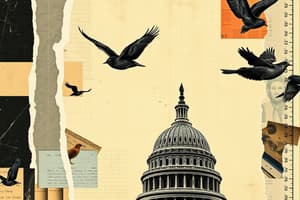Podcast
Questions and Answers
What is the primary aim of the Public Accounts Committee's review of regulatory bodies?
What is the primary aim of the Public Accounts Committee's review of regulatory bodies?
- To enhance the effective use of public funds and improve governmental oversight (correct)
- To investigate private sector regulatory practices
- To amend existing regulations governing public utilities
- To increase the number of regulatory bodies in India
Which regulatory bodies are specifically mentioned as part of the PAC's initiative?
Which regulatory bodies are specifically mentioned as part of the PAC's initiative?
- Telecom Regulatory Authority of India and Securities and Exchange Board of India (correct)
- Competition Commission of India and Food Safety and Standards Authority of India
- Reserve Bank of India and Insurance Regulatory and Development Authority
- National Biodiversity Authority and Central Electric Authority
How many members currently compose the Public Accounts Committee?
How many members currently compose the Public Accounts Committee?
- 26 members
- 22 members (correct)
- 20 members
- 24 members
What is one of the functions of the Public Accounts Committee?
What is one of the functions of the Public Accounts Committee?
When was the Public Accounts Committee first introduced?
When was the Public Accounts Committee first introduced?
Which of the following is NOT a Financial Parliamentary committee in India?
Which of the following is NOT a Financial Parliamentary committee in India?
Who appoints the Chairman of the Public Accounts Committee?
Who appoints the Chairman of the Public Accounts Committee?
What must the members of the CAG committee refrain from doing?
What must the members of the CAG committee refrain from doing?
What prompted the Public Accounts Committee to initiate a review of regulatory bodies?
What prompted the Public Accounts Committee to initiate a review of regulatory bodies?
Which of the following articles from the Constitution empowers the Public Accounts Committee?
Which of the following articles from the Constitution empowers the Public Accounts Committee?
What is a key subject selected by the PAC for suo-motu investigations?
What is a key subject selected by the PAC for suo-motu investigations?
How many members are elected from the Lok Sabha to form the Public Accounts Committee?
How many members are elected from the Lok Sabha to form the Public Accounts Committee?
Which body is responsible for appointing the Chairman of the Public Accounts Committee?
Which body is responsible for appointing the Chairman of the Public Accounts Committee?
In which year was the Public Accounts Committee first introduced?
In which year was the Public Accounts Committee first introduced?
What is one of the PAC's primary functions concerning financial accounts?
What is one of the PAC's primary functions concerning financial accounts?
Which of the following describes a restriction on members of the CAG committee?
Which of the following describes a restriction on members of the CAG committee?
What is the duration of the term for members of the Public Accounts Committee?
What is the duration of the term for members of the Public Accounts Committee?
Which of the following is NOT a primary focus of the Public Accounts Committee?
Which of the following is NOT a primary focus of the Public Accounts Committee?
Flashcards are hidden until you start studying
Study Notes
Public Accounts Committee Review of Regulatory Bodies
- The Public Accounts Committee (PAC) is reviewing the performance of regulatory bodies like SEBI and TRAI.
- This review aims to enhance the effective use of public funds and improve governmental oversight.
- The decision was made amid allegations of conflict of interest against the SEBI chief.
- The PAC is focused on enhancing the effectiveness of regulatory bodies and ensuring accountability.
- The Public Accounts Committee was introduced in 1921 with origins in the Government of India Act, 1919.
- The PAC is one of three Financial Parliamentary Committees in India, alongside the Estimates Committee and the Committee on Public Undertakings.
- The committee is responsible for auditing the revenue and expenditure of the Government of India.
- The PAC comprises 22 members, with a one-year term.
- The committee examines accounts of appropriated funds, including the annual Finance Accounts, and reviews other accounts deemed appropriate.
Public Accounts Committee (PAC) Review of Regulatory Bodies
- The Public Accounts Committee (PAC) has initiated a review of regulatory bodies like SEBI and TRAI.
- The review aims to improve the effective use of public funds and strengthen governmental oversight.
- This decision comes after controversies about conflict of interest allegations against the SEBI chief.
- The PAC has chosen various subjects for investigations, including the performance review of regulatory bodies established by Parliament and the regulation of fees and charges on public infrastructure.
Public Accounts Committee (PAC)
- The PAC is a parliamentary committee responsible for auditing the government's revenue and expenditure.
- It is one of three Financial Parliamentary committees, alongside the Estimates Committee and the Committee on Public Undertakings.
- The PAC was introduced in 1921, following its mention in the Government of India Act, 1919.
- It is constituted annually with 22 members: 15 elected by the Lok Sabha Speaker and 7 by the Rajya Sabha Chairman.
- The PAC serves a one-year term and has the power to examine government expenditure and accounts.
- It can review other government accounts it deems appropriate, excluding those related to Public Undertakings, which are assigned to the Committee on Public Undertakings.
Studying That Suits You
Use AI to generate personalized quizzes and flashcards to suit your learning preferences.



